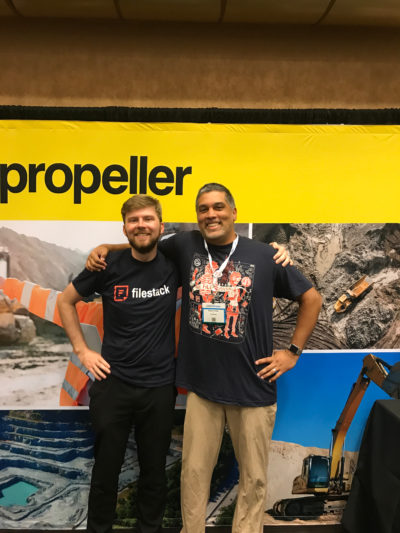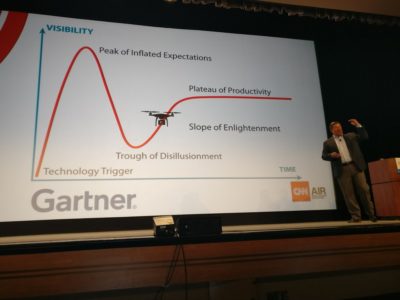Over the past couple of months, we have seen a steady increase in conversations with drone specific prospects at Filestack. Purely looking at demand signals, it made sense to come out to learn more about this booming industry at one of the top billed drone events in North America, Interdrone 2017. What would a file uploading company gain from going to a drone conference you may ask? A LOT.
Drones are creating incredible amounts of data, usually consisting of high quality video and/or thousands — sometimes, millions — of images in any given week. There was a seemingly endless amount of companies and service providers that were focused on the gathering (creation) of data captured by drones, but there was a heavy imbalance to companies whose sole business was to help make sense of the data and provide actionable insights. I was very impressed with Dronifi, AeroVironment, and Propeller as they seemed they were really honed in on not only data collection, but also analysis, insight, and action as two of my first few questions to everyone I spoke with was, “once you collect the data, where does it go? What do you do with it?” I was surprised to find many people simply said their data goes to “the cloud,” others were a bit more specific and said SD cards or on-board storage. I quickly following up with, “how are you getting it to the cloud?” if they mentioned cloud based services. Many companies I spoke with have incredible services based on the information drones collect. Before any of these wonderful tools are put into play, the data has to be transferred from point A (typically SD card) to point B (cloud storage). There was a handful of platforms that offer desktop applications where storage in the cloud only came into play for accessibility, but a good majority of the drone service providers had all their magic in cloud-based applications. After no more than five conversations, I knew we found a major pain point, and service providers did not hold back in their disdain for managing upload infrastructure and dealing with failed uploads and ingestion errors.
First Impressions of InterDrone 2017
I’ll be the first to tell you, I am no drone expert. I have crashed every drone I have ever owned, or bought for my step-children. I do not own a hobbyist drone, yet. I am not a certified pilot, yet. I had the opportunity to learn how to get certified and received numerous tips from a very welcoming community, so my wife thanks you all in advance for the money I’m about to spend.
In my research on the drone industry, and based on conversations with drone service provider prospects at Filestack, I figured Precision Agriculture would be the dominant topic. I was wrong. While Precision Ag was what brought many drone start-ups to market, it was clear to see it was not the only path to revenue. I spoke with over 50 companies at Interdrone, and I found drone use cases covering a variety of industries:
- Precision Agriculture
- Energy
- Insurance
- Government
- Construction
- Mining
- Emergency Rescue
- Survey & Mapping
- Many, many others I can’t even list them all
From 2-person shops like OttoFly building drone SDKs and APIs, to 100+ SMBs like Precision Hawk playing in the hardware, software, and consultation space, and Memery investigating taking a consumer-based application into the commercial space, all the way up to 100,000+ Enterprises (Hello, Intel!), everyone is getting in on the drone action. If you have not heard, or seen the Intel announcement about their new Insights Platform, I highly suggest checking it out. This sounds like a very powerful platform that *will* help make drone data actionable, and I’m excited to see how it is rolled out and what Intel brings to market. Early indications are late 2017, early 2018 for an official launch of the Insights Platform.
Takeaways
- The drone industry is still very young. Lot of talk about pricing models, regulatory actions, insurance, scaling, and data capture.
- Data collection is a big focus, but there are a lot of questions yet to be answered on how to show businesses why they need drones.
- End-to-end solutions that encompassed collection, analysis, and actionable insight were present, but not en masse. I would say it’s safe to say a lot of the companies in attendance are only solving for a piece of the pie. I expect they will have to expand their presence to win more, and especially to attract deep pocketed buyers.
- Data security was a big miss. To me, this was the least discussed topic across the entire conference. Considering the amount of data, and what that data contains, I expected much more scrutiny into how data is handled and accessed.
- Companies that already had established skills, such as surveying, stood out as they are using drones to enhance their offer rather than a company that just “does drones” but doesn’t have additional in-house skill.
- There is a beginning of revolution around flight time and payload capacity, and FlightWave Aerospace is doing some stellar work with their hydrogen powered drone. I couldn’t find a company with more flight time to payload capacity, so this will be fun company to watch!
- Upload workflow is viewed as a “necessary evil.” I heard that exact phrase three times in two days. When presented with a solution, such as the Filestack Upload API, Content Ingestion Network, and Intelligent Ingestion, ears and eyes perked up. People were eager to learn more, as uploading is clearly not something drone service providers want to deal with.
Fun Facts
I now know what it’s like to be a non-techie at a tech conference. So. Many. Acronyms. I was hearing stuff I had never heard of before. Through a lot of conversation, I polished up my drone game a bit, and learned some pretty interesting details about various companies. I asked in advance if it was OK to share these tidbits, and I did receive approval.
- If you’re in the energy game, you better know what the Federal Energy Regulatory Commons (FERC), The North American Electric Reliability Corporation (NERC), and FedRamp are
- ‘Precision Hawk’ was originally named ‘Wine Hawk’ as it was a UAV deployed to keep birds away from vineyards/grapes for winemaking. One of the co-founders thought it’d be fun to put a camera on to get some cool aerial shots, and now, they are playing a whole new ballgame!
- Photogrammetry (layman definition): when you stitch a series of photos together, reducing the overlap/duplication, and creating one high quality image
- BVLOS: beyond visual line of sight
- Sense and Avoid: The capability to remain clear from collisions with other airborne traffic
- Ground Control Plates (GCP) come in an astonishing array of forms and fashions
- Point Cloud: a set of data points in a coordinate system
- Triangulated Irregular Network (TIN): a digital data structure used to represent surface. Using three-dimensional coordinates (x, y, and z), you can get a vector based representation of land surface _or_ sea bottom.
I learned a lot, and am walking away from this conference knowing we’re about to help a lot more drone service providers take data ingestion off their plate. They are building amazing software, and managing uploads is not something they should be spending unnecessary cycles on. If you haven’t had a chance to see the Filestack suite of services that we offer to drone service providers, check out our drone file optimization page. While you’re there, we have published our Intelligent Ingestion whitepaper that goes into detail on how we eliminate network, geography, and device barriers when it comes to uploading files from anywhere in the world.
It’s free to get started, sign up here and let us know if you’d like to test with our advanced uploading features. We’re happy to work with prospects on finding the right fit at the right price, so please do not hesitate to reach out if you have any questions!
Thanks for reading,
Wayne A. Walls
@waynewalls | @filestack
Filestack is a dynamic team dedicated to revolutionizing file uploads and management for web and mobile applications. Our user-friendly API seamlessly integrates with major cloud services, offering developers a reliable and efficient file handling experience.
Read More →


